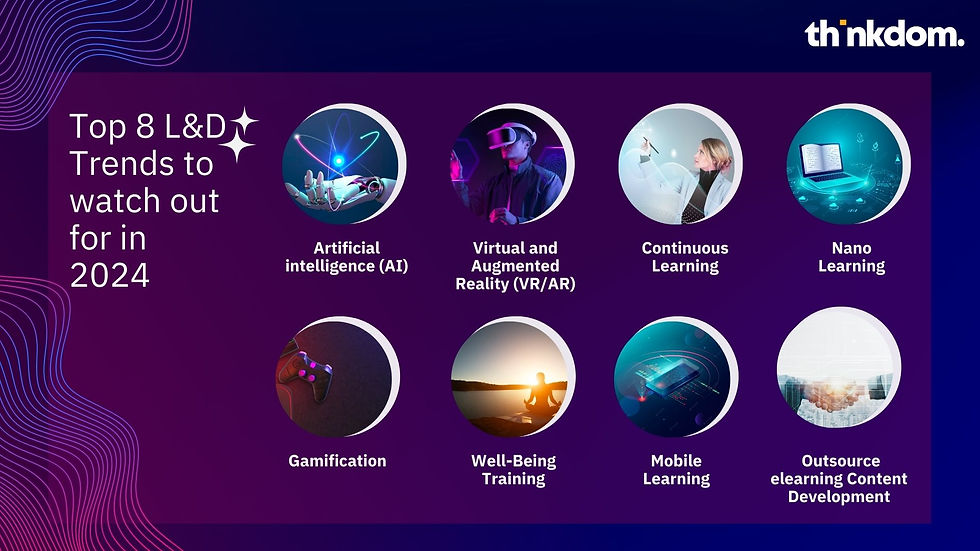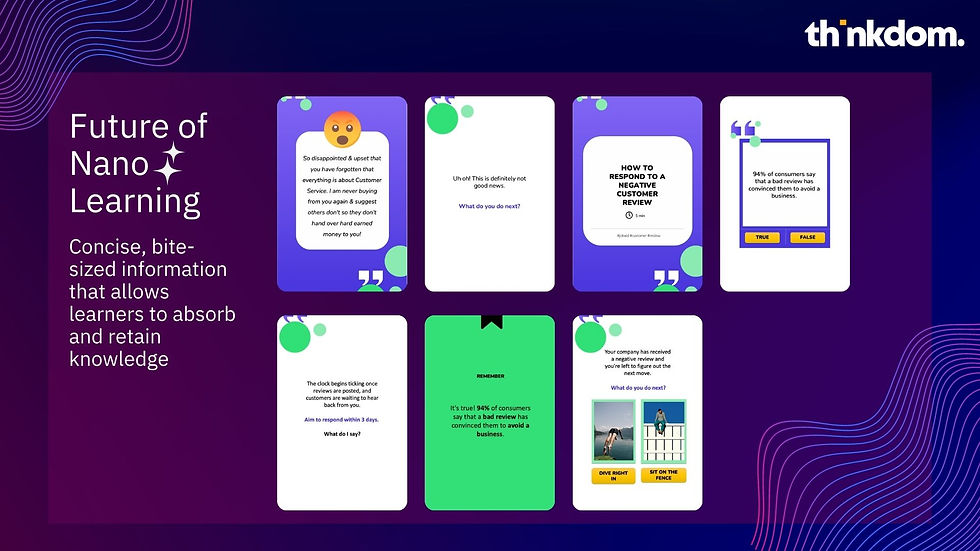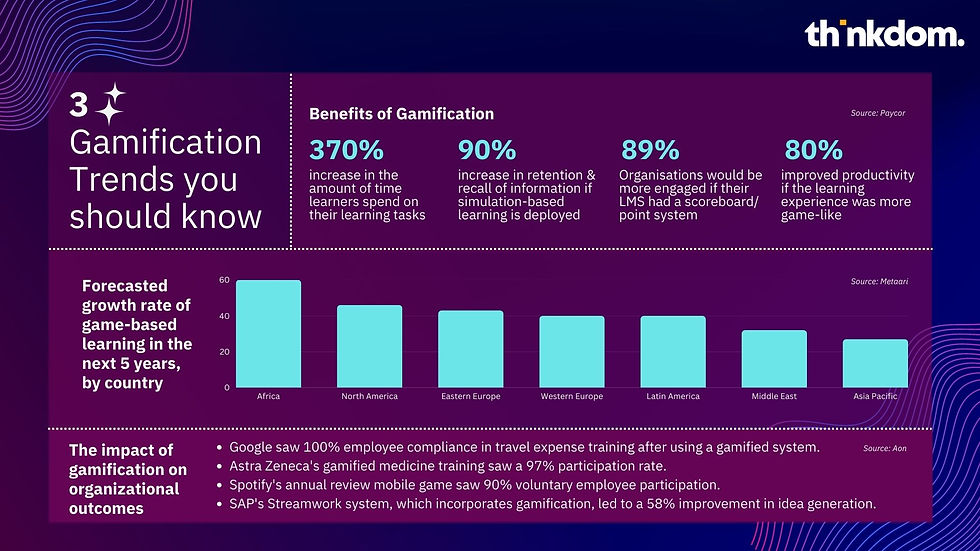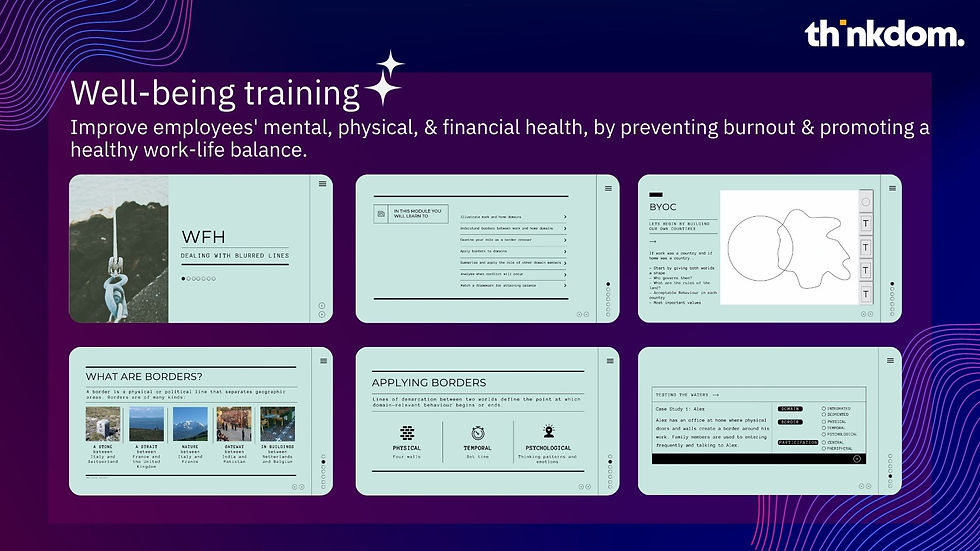Top 8 eLearning (L&D) Trends to watch out for (2024 Updated)
- Neethi Kumar
- Jan 25, 2023
- 4 min read
Updated: Jul 22, 2024

We will be discussing the top 8 eLearning trends to watch out for in 2024, with a focus on how they impact instructional design and L&D. From the use of artificial intelligence to the integration of virtual and augmented reality, these trends will shape the way we learn and the way eLearning content is designed and delivered.
In 2022, eLearning saw a significant increase in popularity as a result of the ongoing COVID-19 pandemic. With many educational institutions and businesses shifting to remote learning, eLearning became a crucial tool for continuing education and training.
Additionally, the trend of "anytime, anywhere" learning continued to gain momentum as more and more people realised the convenience and flexibility of eLearning. In this blog, we will be discussing this year’s trends in detail, and how they will impact the eLearning industry in the coming years. So, let's dive in and explore the top eLearning trends to watch out for in 2024.

1. Increased use of artificial intelligence (AI) in eLearning
AI-powered eLearning will become more prevalent in 2024, with the use of chatbots, personalised learning, and adaptive learning becoming more common. Artificial Intelligence (AI) is revolutionising the eLearning industry by providing personalized learning experiences for students. AI-powered tools such as Grammarly, Duolingo, and Thinkster allow learners to adopt learning styles that suit them and provide 24/7 support through chatbots for instant feedback. This self-serve approach encourages learners to perform better.. As AI technology continues to advance, we can expect to see an increase in the use of AI-supported online learners in 2024.
2. The integration of virtual and augmented reality (VR/AR) in eLearning
VR and AR will be used more extensively in eLearning to create immersive and interactive learning experiences. Virtual and Augmented Reality (VR/AR) technology is becoming increasingly affordable and widespread in the eLearning industry. VR allows learners to experience simulations of real-world scenarios, making for a highly immersive learning experience, while AR allows for a more flexible and contextual learning experience by overlaying digital content in the real world. Both VR and AR provide engaging and immersive learning experiences, and they allow for more interactive and personalised learning. By 2024, VR and AR will be widely used in eLearning courses, providing learners with a highly immersive and engaging learning experience.
3. Greater investment in continuous learning
With the high turnover rate of employees, organisations are focusing on investing in continuous learning as a way to retain and attract top talent. A culture of continuous learning, where employees feel heard, valued, and motivated, leads to better performance and stronger teams. This year, organisations are focusing on providing employees with opportunities to upskill or reskill for current and future job roles, through various training programs such as technical skills, leadership development, and diversity and inclusion training. By designing these programs with employees' futures in mind, companies can show their commitment to their growth and development.
4. The beginning of nano learning

As an organisation, implementing nano-learning into your employee training strategy provides a solution for concise and easy-to-absorb information. This bite-sized learning style, using resources such as texts, short videos, and sound bites, caters to the younger generation, especially Gen Z, and their shorter attention span in the digital age. With the average human attention span decreasing and the world revolving more around digital tools and information, nano-learning is a trend that is expected to grow in 2024. It is an irreplaceable and effective way of providing training in the current digital age.
5. Increased use of gamification in eLearning

Gamification will be used more extensively in eLearning to make it more engaging and interactive. As an organisation, incorporating gamification into your employee training strategy can increase engagement and retention. Studies show that 80% of US workers find game-based learning more engaging and enjoyable. Additionally, research indicates that gamification can improve outcomes by 45.5% and 60.67% when combined with reading, proving its effectiveness. Platforms such as Khan Academy, Duolingo, and SoloLearn utilise gamification in their learning approach.
6. Greater importance to well-being training

In 2024, organisations are expected to prioritise employee well-being by offering training programs that focus on mental, physical, and financial well-being. These programs will address issues such as burnout, work-life balance, and financial wellness. They will also provide training on personal development topics such as productivity hacks, mindfulness, taking time off, and managing personal finances to reduce stress. This shift in focus towards employee well-being highlights the importance of maintaining a healthy work-life balance and the real risk of burnout to employee health and happiness.
7. The continued growth of Mobile Learning
The trend of mobile learning has been growing in recent years as people's busy schedules make it difficult to attend long training sessions. However, with the outbreak of the COVID-19 pandemic and the shift to online learning, mobile training solutions have become even more necessary. This shift has accelerated the transformation towards digitizing operations and realising the importance of mobile learning. As mobile learning continues to evolve, we can expect to see advancements in compatibility and responsiveness to minimize compatibility issues and improve the overall user experience.
8. The increased need to outsource e-learning content development
Efficient eLearning content is crucial to the success of training sessions. While some companies may choose to develop their own modules, the outcome may not always be the best. To create engaging eLearning content, it is important to curate relevant information and use a variety of content forms. Outsourcing eLearning content development to experts can be a beneficial solution as they have the knowledge and experience to create practical training modules that align with a company's expertise. Additionally, outsourcing allows for the inclusion of well-planned assessments to gauge the learners' understanding of the material and provide immediate feedback.
Wrapping it up
In summary, the top seven trends in learning and training development for 2024 include AI-powered personalised learning, VR/AR technology, gamification, nano-learning, employee well-being training, and more. L&D teams are currently at the forefront of these rapid technology breakthroughs and are investing time and energy in retraining and upskilling employees, as well as implementing cost-cutting technologies and practices. To stay up-to-date with market changes and enhance your company's training program, consider partnering with the right vendor who will keep you ahead of the curve. By staying informed and utilizing these trends, companies can strengthen the impact of their L&D strategies and set themselves up for success.



